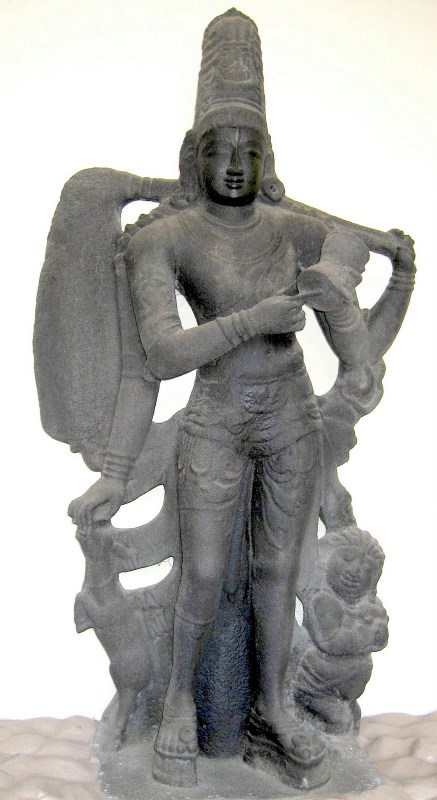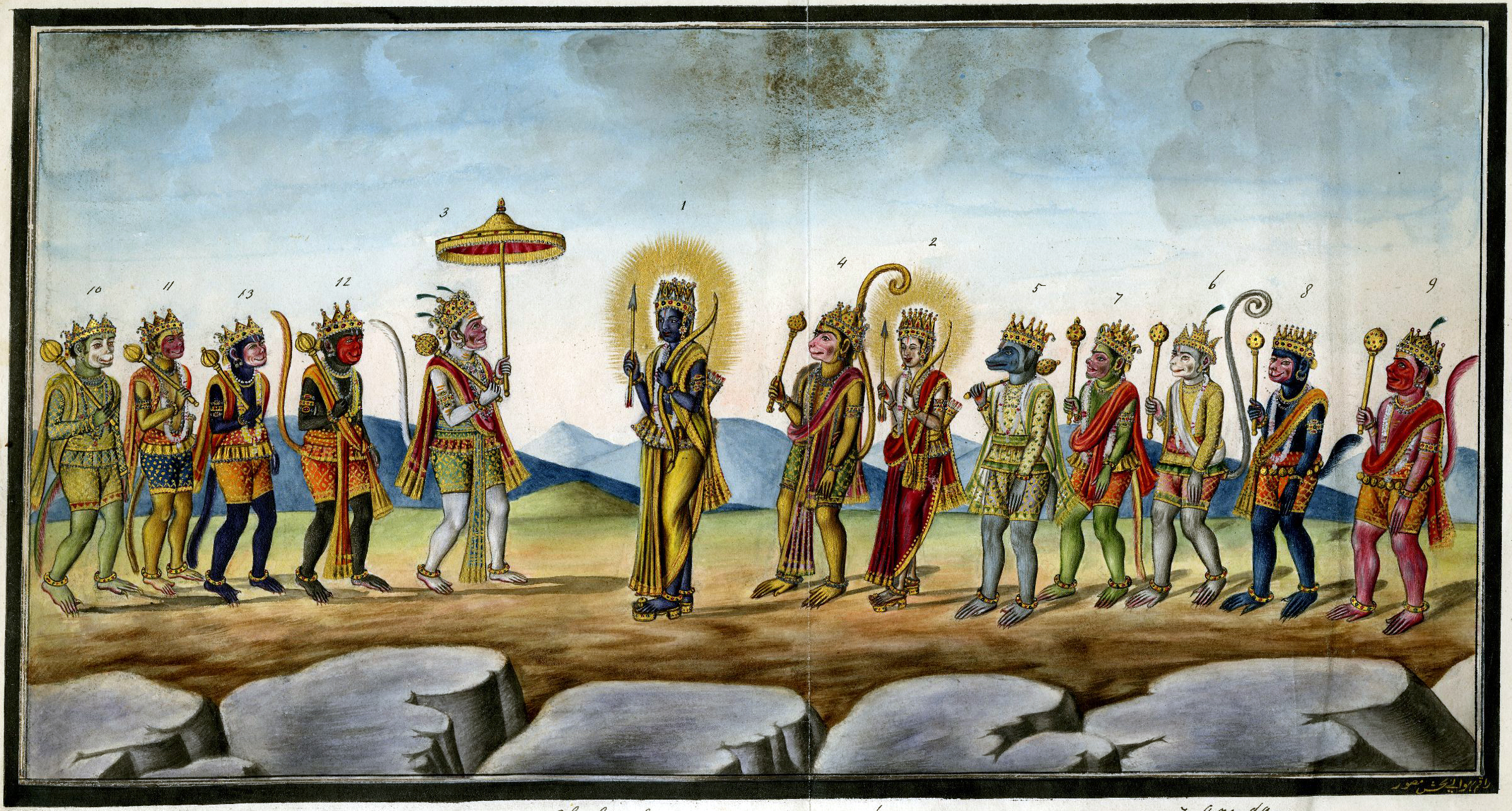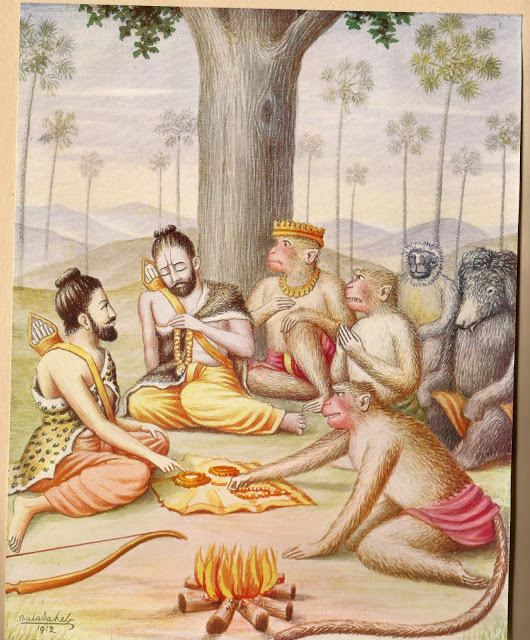|
Vishwaksena
Vishvaksena ()Nayar p. 103 or Vishwaksena, is the commander-in-chief of the army of the Hindu deity Vishnu, additionally serving as a gatekeeper and chamberlain of his celestial abode of Vaikuntha. As the embodiment of the tantras, Vishvaksena is worshipped before any ritual or function in the Vaikhanasas and Sri Vaishnavism sects. He occupies an important place in Vaikhanasa and Pancaratra temple traditions, where temple festivals often begin with his worship and procession. Iconography and associations The ''Kurma Purana'' describes Vishvaksena to have born out of a portion of Vishnu, carrying a conch (shankha), Sudarshana Chakra (discus) and gada (mace) and wearing yellow clothes like his master. The ''Kalika Purana'' describes him as an attendant of Vishnu, who has four arms, and is red and brown in complexion. He seats on a white lotus, has long beard and wears matted hair. He carries a lotus, gada, shanka, and chakra in his hands.Dalal p. 462 The Pancharatra text '' L ... [...More Info...] [...Related Items...] OR: [Wikipedia] [Google] [Baidu] |
Sri Vaishnavism
Sri Vaishnavism, or the Sri Vaishnava Sampradaya, is a denomination within the Vaishnavism tradition of Hinduism. The name refers to goddess Lakshmi (also known as Sri), as well as a prefix that means "sacred, revered", and the god Vishnu, who are together revered in this tradition. The tradition traces its roots to the ancient Vedas and Pancharatra texts, popularised by the Alvars and their canon, the Naalayira Divya Prabandham. The founding of Sri Vaishnavism is traditionally attributed to Nathamuni of the 10th century CE; its central philosopher has been Ramanuja of the 11th century, who developed the ''Vishishtadvaita'' ("qualified non-dualism") Vedanta sub-school of Hindu philosophy. The tradition split into two denominations around the 16th century. The Vadakalai sect vested the Vedas with the greatest authority and follow the doctrine of Sri Vedanta Desika, whereas the Tenkalai sect vested the Naalayira Divya Prabandham with the greatest authority and follow the princip ... [...More Info...] [...Related Items...] OR: [Wikipedia] [Google] [Baidu] |
Vishnu
Vishnu ( ; , ), also known as Narayana and Hari, is one of the principal deities of Hinduism. He is the supreme being within Vaishnavism, one of the major traditions within contemporary Hinduism. Vishnu is known as "The Preserver" within the Trimurti, the triple deity of supreme divinity that includes Brahma and Shiva.Gavin Flood, An Introduction to Hinduism' (1996), p. 17. In Vaishnavism, Vishnu is the supreme being who creates, protects, and transforms the universe. In the Shaktism tradition, the Goddess, or Adi Shakti, is described as the supreme Para Brahman, yet Vishnu is revered along with Shiva and Brahma. Tridevi is stated to be the energy and creative power (Shakti) of each, with Lakshmi being the equal complementary partner of Vishnu. He is one of the five equivalent deities in Panchayatana puja of the Smarta tradition of Hinduism. According to Vaishnavism, the highest form of Ishvara is with qualities (Saguna), and have certain form, but is limitless, transcend ... [...More Info...] [...Related Items...] OR: [Wikipedia] [Google] [Baidu] |
Nelumbo Nucifera
''Nelumbo nucifera'', also known as sacred lotus, Laxmi lotus, Indian lotus, or simply lotus, is one of two extant species of aquatic plant in the family Nelumbonaceae. It is sometimes colloquially called a water lily, though this more often refers to members of the family Nymphaeaceae. Lotus plants are adapted to grow in the flood plains of slow-moving rivers and delta areas. Stands of lotus drop hundreds of thousands of seeds every year to the bottom of the pond. While some sprout immediately, and most are eaten by wildlife, the remaining seeds can remain dormant for an extensive period of time as the pond silts in and dries out. During flood conditions, sediments containing these seeds are broken open, and the dormant seeds rehydrate and begin a new lotus colony. Under favorable circumstances, the seeds of this aquatic perennial may remain viable for many years, with the oldest recorded lotus germination being from seeds 1,300 years old recovered from a dry lakebed in n ... [...More Info...] [...Related Items...] OR: [Wikipedia] [Google] [Baidu] |
Ägama (Hinduism)
The Agamas (Devanagari: , IAST: ) are a collection of several Tantric literature and scriptures of Hindu schools.Julius Lipner (2004), Hinduism: the way of the banyan, in The Hindu World (Editors: Sushil Mittal and Gene Thursby), Routledge, , pages 27â28 The term literally means tradition or "that which has come down", and the Agama texts describe cosmology, epistemology, philosophical doctrines, precepts on meditation and practices, four kinds of yoga, mantras, temple construction, deity worship and ways to attain sixfold desires. These canonical texts are in Tamil and Sanskrit. Agamas were predominant in South India but Sanskritized later. The three main branches of Agama texts are Shaiva, Vaishnava, and Shakta. The Agamic traditions are sometimes called Tantrism, although the term "Tantra" is usually used specifically to refer to Shakta Agamas.Mariasusai Dhavamony (1999), Hindu Spirituality, Gregorian University and Biblical Press, , pages 31â34 with footnotes The Agama l ... [...More Info...] [...Related Items...] OR: [Wikipedia] [Google] [Baidu] |
Dharma Shastra
Dharma (; sa, धरà¥à¤®, dharma, ; pi, dhamma, italic=yes) is a key concept with multiple meanings in Indian religions, such as Hinduism, Buddhism, Jainism, Sikhism and others. Although there is no direct single-word translation for ''dharma'' in European languages, it is commonly translated as "righteousness", "merit" or "religious and moral duties" governing individual conduct.Britannica, The Editors of Encyclopaedia. (9 April 2019)Dharma. ''Encyclopedia Britannica''. Accessed 14 September 2021. In Hinduism, dharma is one of the four components of the ''Puruá¹£Ärtha'', the aims of life, and signifies behaviours that are considered to be in accord with ''á¹ta'', the order that makes life and universe possible. It includes duties, rights, laws, conduct, virtues and "right way of living".see: *"Dharma", ''The Columbia Encyclopedia'', 6th Ed. (2013), Columbia University Press, Gale, ; *Steven Rosen (2006), Essential Hinduism, Praeger, , Chapter 3. It had a transtemporal ... [...More Info...] [...Related Items...] OR: [Wikipedia] [Google] [Baidu] |
Vedas
upright=1.2, The Vedas are ancient Sanskrit texts of Hinduism. Above: A page from the '' Atharvaveda''. The Vedas (, , ) are a large body of religious texts originating in ancient India. Composed in Vedic Sanskrit, the texts constitute the oldest layer of Sanskrit literature and the oldest scriptures of Hinduism. There are four Vedas: the Rigveda, the Yajurveda, the Samaveda and the Atharvaveda. Each Veda has four subdivisions â the Samhitas (mantras and benedictions), the Aranyakas (text on rituals, ceremonies, sacrifices and symbolic-sacrifices), the Brahmanas (commentaries on rituals, ceremonies and sacrifices), and the Upanishads (texts discussing meditation, philosophy and spiritual knowledge).Gavin Flood (1996), ''An Introduction to Hinduism'', Cambridge University Press, , pp. 35â39A Bhattacharya (2006), ''Hindu Dharma: Introduction to Scriptures and Theology'', , pp. 8â14; George M. Williams (2003), Handbook of Hindu Mythology, Oxford University Press, , p ... [...More Info...] [...Related Items...] OR: [Wikipedia] [Google] [Baidu] |
Treta Yuga
''Treta Yuga'', in Hinduism, is the second and second best of the four ''yugas'' (world ages) in a ''Yuga Cycle'', preceded by '' Krita (Satya) Yuga'' and followed by '' Dvapara Yuga''. ''Treta Yuga'' lasts for 1,296,000 years (3,600 divine years). ''Treta'' means 'a collection of three things' in Sanskrit, and is so called because during the ''Treta Yuga'', there were three Avatars of Vishnu that were seen, the fifth, sixth and seventh incarnations as Vamana, Parashurama and Rama, respectively. The bull of Dharma symbolizes that morality stood on three legs during this period. It had all four legs in the ''Satya Yuga'' and two in the succeeding ''Dvapara Yuga''. Currently, in the immoral age of ''Kali'', it stands on one leg. Etymology ''Yuga'' ( sa, यà¥à¤), in this context, means "an age of the world", where its archaic spelling is ''yug'', with other forms of ''yugam'', , and ''yuge'', derived from ''yuj'' ( sa, यà¥à¤à¥, , to join or yoke), believed derived from ' (Pr ... [...More Info...] [...Related Items...] OR: [Wikipedia] [Google] [Baidu] |
Vanara
In Hindu, Vanara ( sa, वानर, , forest-dwellers) are either monkeys, apes, or a race of forest-dwelling people. In the epic the ''Ramayana'', the Vanaras help Rama defeat Ravana. They are generally depicted as humanoid apes, or human-like beings. Etymology There are three main theories about the etymology of the word "Vanara": * Aiyanar suggests that ''vanara'' means "monkey" derived from the word ''vana'' ("forest"), Literally meaning "belonging to the forest" Monier-Williams says it is probably derived from ''vanar'' (lit. "wandering in the forest") and means "forest-animal" or monkey. * Devdutt Pattanaik suggests that it derives from the words ''vana'' ("forest"), and ''nara'' ("man"), thus meaning "forest man" and suggests that they may not be monkeys, which is the general meaning. * It may be derived from the words ''vav'' and ''nara'', meaning "is it a man?" (meaning "monkey") or "perhaps he is man". Identification Although the word Vanara has come to mean ... [...More Info...] [...Related Items...] OR: [Wikipedia] [Google] [Baidu] |
Sugreeva
''This character is about the vanara, in the Ramayana.'' Sugriva ( sa, सà¥à¤à¥à¤°à¥à¤µ, , ) is a character In the ancient Indian epic Ramayana. He is the younger brother of Vali, whom he succeeded as ruler of the vanara kingdom of Kishkindha. RumÄ is his wife. He is a son of Surya, the Hindu deity of the sun. As the king of the vanaras, Sugriva aided Rama in his quest to liberate his wife Sita from captivity at the hands of the rakshasa king Ravana. Nomenclature He is also known as jv, Sugriwa, th, Su-khrip, lo, Sugeep, km, Sukhreeb, Creole language, Creole: ''Soogrim'', lo, Sangkip, ta, Cukkirivan, my, Thugyeik, Sugreeva or Sugreev. Legend The story of Sugriva is part of Ramayana and in an abbreviated version, is also present in the Mahabharata. The king of Kishkindha, Vrikshraja, was a divine creature born from Brahmaâs tilaka. He had the body of a human and face and tail of a monkey. He was instructed to roam the forests and kill demons. One day, Vriks ... [...More Info...] [...Related Items...] OR: [Wikipedia] [Google] [Baidu] |
Puranas
Purana (; sa, , '; literally meaning "ancient, old"Merriam-Webster's Encyclopedia of Literature (1995 Edition), Article on Puranas, , page 915) is a vast genre of Indian literature about a wide range of topics, particularly about legends and other traditional lore. The Puranas are known for the intricate layers of symbolism depicted within their stories. Composed originally in Sanskrit and in Languages of India, other Indian languages,John Cort (1993), Purana Perennis: Reciprocity and Transformation in Hindu and Jaina Texts (Editor: Wendy Doniger), State University of New York Press, , pages 185-204 several of these texts are named after major Hindu gods such as Vishnu, Shiva, Brahma, and Adi Shakti. The Puranic genre of literature is found in both Hinduism and Jainism. The Puranic literature is encyclopedic, and it includes diverse topics such as cosmogony, cosmology, genealogies of gods, goddesses, kings, heroes, sages, and demigods, folk tales, pilgrimages, temples, medic ... [...More Info...] [...Related Items...] OR: [Wikipedia] [Google] [Baidu] |
Garga Samhita (Vaishnavite Text)
''Garga-samhita'' ( sa, à¤à¤°à¥à¤ सà¤à¤¹à¤¿à¤¤à¤¾, IAST: Garga-saá¹hitÄ) is an ancient Indian Sanskrit-language Vaishnavite biography of Krishna. Its authorship is attributed to the sage Garga, the family priest of Krishna's foster father Nanda. It is the earliest text that associates Krishna and Gopis with the Holi festival. Chapters ''Garga-Sanmita'' contains 11 ''khandas'' or parts: See also * Brahma Samhita * Brahma Vaivarta Purana The ''Brahmavaivarta Purana'' ( sa, बà¥à¤°à¤¹à¥à¤®à¤µà¥à¤µà¤°à¥à¤¤ पà¥à¤°à¤¾à¤£; ) is a voluminous Sanskrit text and a major Purana (''Maha-purana'') of Hinduism. It is an important Vaishnavism text. This Purana majorly centers aroun ... Notes References Further reading * {{cite book , author1=Garga , author2=Danavir Goswami , author3=KuÅakratha DÄsa , title=ÅrÄ« Garga-saá¹hitÄ , url=https://books.google.com/books?id=pRpMnwEACAAJ , year=2006 , publisher=Rupanuga Vedic College , isbn=978-1-934405-21- ... [...More Info...] [...Related Items...] OR: [Wikipedia] [Google] [Baidu] |
Brihad Bhagavatamrita
''Brihad-bhagavatamrita'' is a sacred text for followers of the Hindu tradition of Gaudiya Vaishnavism. Along with ''Hari-bhakti-vilasa'', it is one of the most important works of Vaishnava theologian Sanatana Goswami. While ''Hari-bhakti-vilasa'' sets out guidance for Vaishnava behavior and ritual, ''Brihad-bhagavatamrita'' contains an analysis of the teachings of Chaitanya from an ontological and metaphysical perspective. Contents Sri Brhad-bhagavatÄmá¹ta is divided in two cantos: PÅ«rva-khaá¹á¸a, or first, and Uttar-khaá¹á¸a, or last. The name of the First Canto is ÅrÄ« Bhagavat-ká¹pÄ-sÄra-nirdhÄraá¹a khaá¹á¸a â Ascertaining the Essence of the Mercy of the Supreme Lord. The Second Canto is known as ÅrÄ« GolokamÄhÄtmya- nirÅ«paá¹a khaá¹á¸a â Ascertaining the Glories of ÅrÄ« Goloka.ÅrÄ« Brhat BhÄgavatÄmta Second Canto by Sri Srimad Bhakti vedÄnta Narayana GosvÄmi MahÄrÄja In the first part of ''Brihad-bhagavatamrita'' Sanatana Goswami has des ... [...More Info...] [...Related Items...] OR: [Wikipedia] [Google] [Baidu] |









